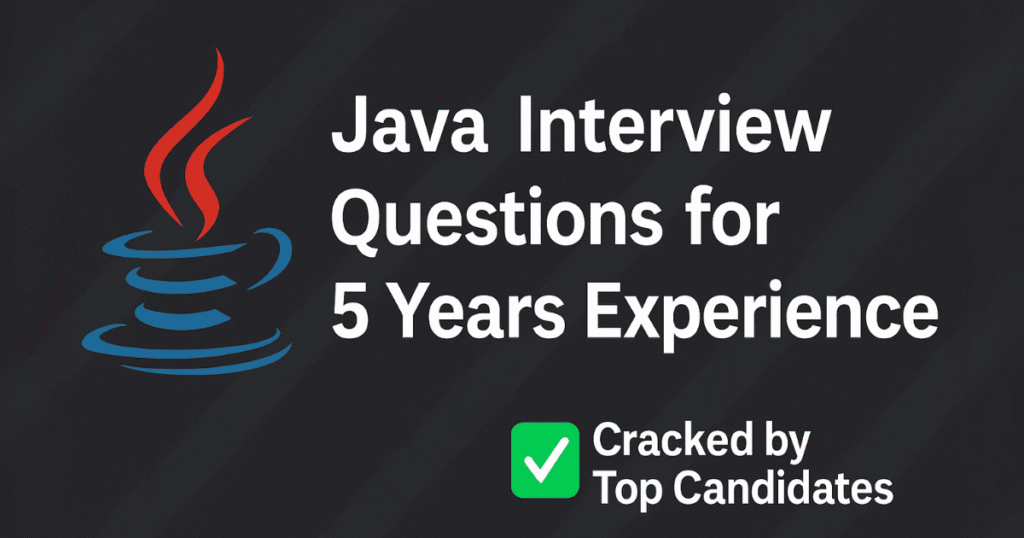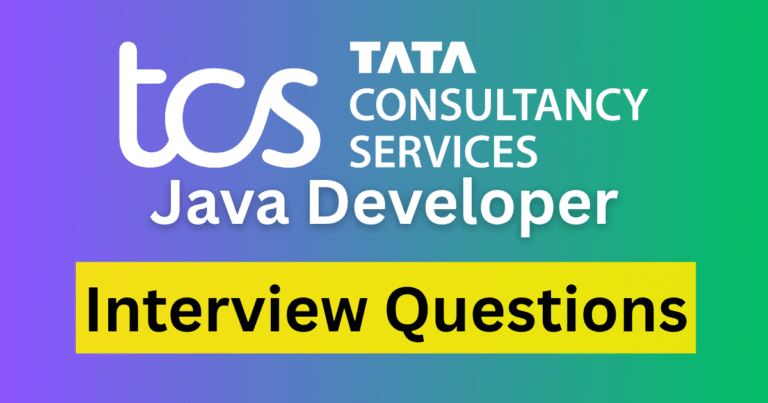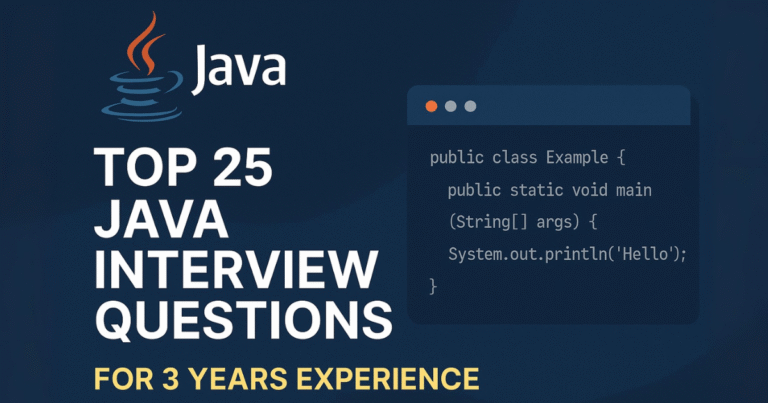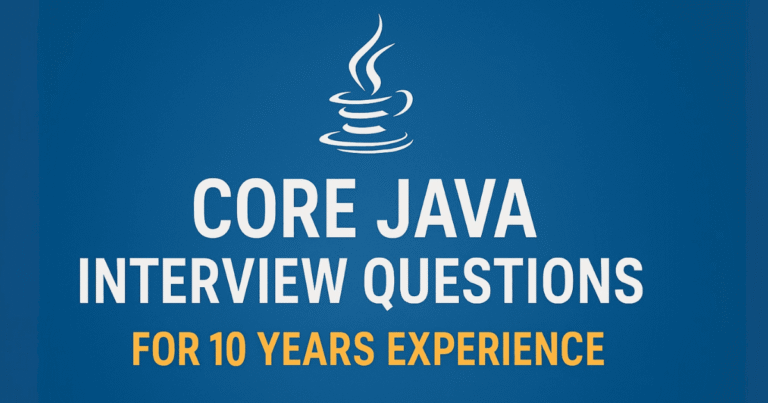2025 Top Java Interview Questions for 5 Years Experienced (With Answers)
Are you a Java developer with 5 years of experience preparing for your next big interview? Whether you’re interviewing at a product company or an enterprise-level MNC, you’ll be expected to know core Java concepts, Java 8, collections, multithreading, Spring, design patterns, and more. This guide covers the most commonly asked Java interview questions and answers tailored to your experience level.

If you’re searching for the most commonly asked Java interview questions for 5 years experience, this post is the ultimate guide. These questions reflect what top companies expect from a mid-level Java developer.
Real-World Core Java Interview Questions for 5 Years Experience
1. What is the difference between == and .equals() in Java?
// == checks reference equality
// .equals() checks value equality
String a = new String("hello");
String b = new String("hello");
System.out.println(a == b); // false
System.out.println(a.equals(b)); // true
2. How does HashMap work internally?
- Uses an array of Nodes (buckets)
- Each Node contains key, value, hash, and a reference to the next node
- Hash function is applied to key to get bucket index
- Collisions are handled using chaining (LinkedList or Tree from Java 8)
3. Difference between ArrayList and LinkedList
ArrayList:
- Uses dynamic array
- Fast for read (get by index)
- Slow insert/delete in middle
LinkedList:
- Doubly linked list
- Fast insert/delete in middle
- Slow access by index
4. What is the significance of String immutability?
- Security: can't be changed after creation
- Hashcode caching: safe for HashMap
- Thread-safety
- String pool reuse
5. What is the difference between shallow copy and deep copy?
// Shallow copy: same reference
Object a = new Object();
Object b = a; // shallow
// Deep copy: new reference, cloned content
Object b = new Object(a); // deep (custom implementation needed)
Multithreading & Concurrency
6. What is the volatile keyword?
- Tells the JVM that a variable can be updated by multiple threads
- Ensures visibility of changes across threads
- Doesn't guarantee atomicity
7. Difference between wait() and sleep()?
wait():
- Releases the monitor
- Can only be called from synchronized block
sleep():
- Doesn't release lock
- Can be called from anywhere
8. What is the difference between synchronized method and block?
synchronized void method() { }
void method() {
synchronized(this) {
// critical section
}
}
9. What is ExecutorService in Java?
ExecutorService executor = Executors.newFixedThreadPool(5);
executor.submit(() -> System.out.println("Task executed"));
executor.shutdown();
10. How to avoid deadlocks in Java?
- Always acquire locks in the same order
- Use tryLock with timeout
- Avoid holding multiple locks
Java 8 Features
11. What are lambda expressions?
List<String> list = Arrays.asList("a", "b", "c");
list.forEach(s -> System.out.println(s));
12. What is the difference between map() and flatMap()?
List<List<String>> list = Arrays.asList(Arrays.asList("a"), Arrays.asList("b"));
list.stream().flatMap(Collection::stream).forEach(System.out::println);
13. What is Optional in Java 8?
Optional<String> name = Optional.ofNullable("John");
name.ifPresent(System.out::println);
14. What are default and static methods in interfaces?
interface Vehicle {
default void start() { System.out.println("Start"); }
static void stop() { System.out.println("Stop"); }
}
Java Interview Questions For 5 Years Experience From Collections
15. Difference between HashMap and ConcurrentHashMap
HashMap:
- Not thread-safe
- Can throw ConcurrentModificationException
ConcurrentHashMap:
- Thread-safe using segments
- No locking for read
16. What is a fail-fast and fail-safe iterator?
Fail-fast:
- Throws exception if modified during iteration (ArrayList, HashMap)
Fail-safe:
- Uses a clone for iteration (CopyOnWriteArrayList)
17. What is the difference between HashSet and TreeSet?
HashSet:
- Uses hash table
- No order
TreeSet:
- Uses TreeMap
- Sorted order
JVM & Memory
18. What is the Java Memory Model?
- Defines rules for thread interactions
- Ensures visibility and ordering
19. How does garbage collection work?
- Young Generation: short-lived objects
- Old Generation: long-lived objects
- GC collects unreachable objects
20. What is a memory leak in Java?
- When unused objects are not garbage collected
- Caused by unintended strong references
Design Patterns
21. How do you implement a thread-safe Singleton in Java?
public class Singleton {
private static volatile Singleton instance;
private Singleton() {}
public static Singleton getInstance() {
if (instance == null) {
synchronized (Singleton.class) {
if (instance == null) {
instance = new Singleton();
}
}
}
return instance;
}
}
22. What is the Factory Pattern?
interface Shape { void draw(); }
class Circle implements Shape { public void draw() { System.out.println("Circle"); } }
class ShapeFactory {
public Shape getShape(String type) {
if (type.equals("circle")) return new Circle();
return null;
}
}
23. What are SOLID principles?
S - Single Responsibility
O - Open/Closed
L - Liskov Substitution
I - Interface Segregation
D - Dependency Inversion
Spring Framework
24. What is Dependency Injection?
- Objects receive dependencies from external source
- Promotes loose coupling
25. What are the types of bean scopes in Spring?
- Singleton (default)
- Prototype
- Request (web)
- Session (web)
26. What is @Transactional used for?
@Transactional
public void saveData() {
// Executes within a transaction
}
Practical Coding Questions
27. Reverse a string in Java
String input = "hello";
String reversed = new StringBuilder(input).reverse().toString();
28. Find the first non-repeating character
String s = "swiss";
Map<Character, Integer> map = new LinkedHashMap<>();
for (char c : s.toCharArray()) map.put(c, map.getOrDefault(c, 0) + 1);
for (Map.Entry<Character, Integer> e : map.entrySet())
if (e.getValue() == 1) {
System.out.println(e.getKey());
break;
}
29. Implement LRU Cache (with LinkedHashMap)
class LRUCache<K, V> extends LinkedHashMap<K, V> {
private final int capacity;
public LRUCache(int capacity) {
super(capacity, 0.75f, true);
this.capacity = capacity;
}
protected boolean removeEldestEntry(Map.Entry<K, V> eldest) {
return size() > capacity;
}
}
FAQs
What topics should a 5 year experienced Java developer focus on?
Core Java, OOP, Collections, Java 8, Multithreading, Spring, Design Patterns, System Design.
Is Spring Boot necessary for Java backend roles?
Yes. It’s widely used in real-world enterprise backend development.
What is the most asked Java 8 concept in interviews?
Stream API, Lambda Expressions, and Optional.
How important is understanding the JVM?
Very important. JVM internals help with performance tuning and troubleshooting.
Should I practice DSA for Java interviews after 5 years?
Yes. Problem-solving skills are still key for senior developer roles.
🧾 Helpful Resources
Conclusion
Master these Java interview questions to confidently face any senior-level Java interview. Whether you’re targeting product companies, startups, or MNCs, these topics are essential to crack the interview.





